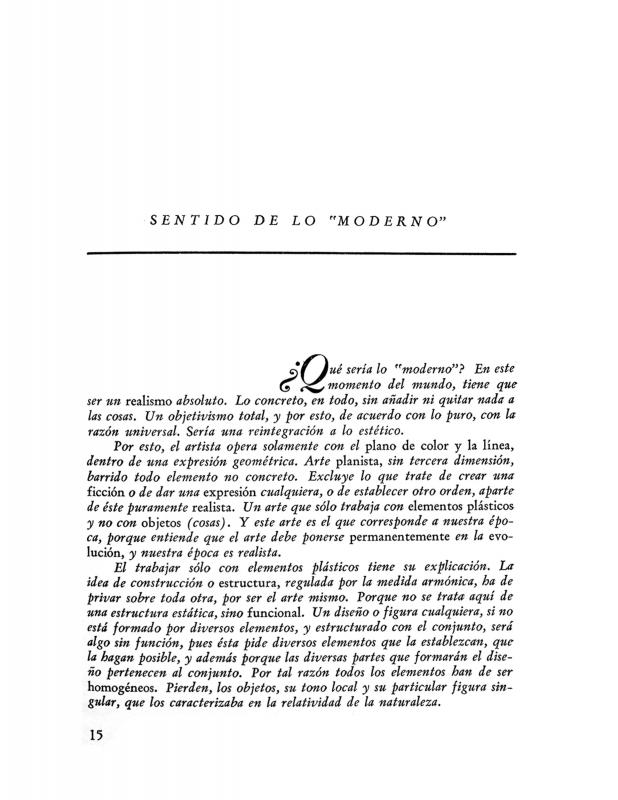Carlos Herrera Mac Lean, was an architect and classmate of the son of the artist Pedro Figari (Uruguay, 1861–1938) who ardently defended the work done at the Escuela de Artes e Industrias by Figari (1915–17) from since he attended the Círculo de Bellas Artes. He was an unconditional admirer of Figari’s work during the Uruguayan’s artistic trajectory in Paris and later became the organizer and curator of the great posthumous retrospective of Figari in 1944. That same year, Joaquín Torres García, published his book Universalismo Constructivo where he had established the basis of his artistic vision. Some of the intellectuals of the Uruguayan artistic medium, as was the case of Herrera Mac Lean, rejected the innovations of the visual arts imparted by the TTG (Taller Torres García [Torres García Worhshop]) and from that perspective they developed a generalized critique of the European avant-garde movements claiming a nationalist and traditionalist posture opposed to the universalist pretensions of both constructive art and abstract art in general.
In 1944, and for the first time, Joaquín Torres García decided to present his work and the work by some of the students from his workshop in Montevideo to the Salón Nacional. He used a landscape theme (based on the notes he made in Europe) that in a way was a tributary addressing the legacy of Paul Cézanne. The jury’s first surprise was encountering a “figurative” landscape painting after Joaquín Torres García had spent ten years during which had been preaching an abstract and universal constructivism.
The explanations that the Architect Carlos Herrera Mac-Lean, one of the judges at the Salon Nacional that awards the grand prize to the Master, developed about the doubts and perplexities that the deliberative body faced, included both praises on his personality and trajectory, as well as harsh criticisms on his constructivist doctrine, considering the work as “a depleted epigone of the various cubistic schools”. The fact that Joaquín Torres García that year had, together with a group of students from the TTG, painted the murals of the Saint Bois Hospital, introduced in the jury the fear that the award (based on the merit of his trajectory) was interpreted as a boost to his recent mural work, and which Herrera Mac-Lean considered “flamboyant and aggressive [...]”, a violent work, which under a visual arts position can be called a painting.” The long argument and the terms by the jury were explicit and finalized with ruling the grand prize in his favor, however, separating his noted trajectory (to which he devoted such dedication) and of what had been his recent mural interventions in the Pavilion Saint Bois.
The brief public controversy between these two personalities began with this article by Herrera in the newspaper El Día, October 13th, 1944. It continued with the response that Joaquín Torres García published, October 21st of that year in the weekly magazine Marcha [Please refer to the ICAA digital archive on the subject: “El problema de la decoración mural. Contestando al Arquitecto señor Herrera Mac Lean” (doc. no. 1228503) and ends with another article written by Herrera: “La aparición de un tercer Torres García” (doc. no. 1228522)]).
[For further reading, please refer to the ICAA digital archive for the following texts written by Joaquín Torres García: “Con respecto a una futura creación literaria” (doc. no. 730292), “Lección 132. El hombre americano y el arte de América” (doc. no. 832022), “Mi opinión sobre la exposición de artistas norteamericanos: contribución” (doc. no. 833512), “Nuestro problema de arte en América: lección VI del ciclo de conferencias dictado en la Facultad de Humanidades y Ciencias de Montevideo” (doc. no. 731106), “Introducción [en] Universalismo Constructivo” (doc. no. 1242032), “Sentido de lo moderno [en Universalismo Constructivo]” (doc. no. 1242015), “Bases y fundamentos del arte constructivo” (doc. no. 1242058) and “Manifiesto 2, Constructivo 100%” (doc. no. 1250878)].










